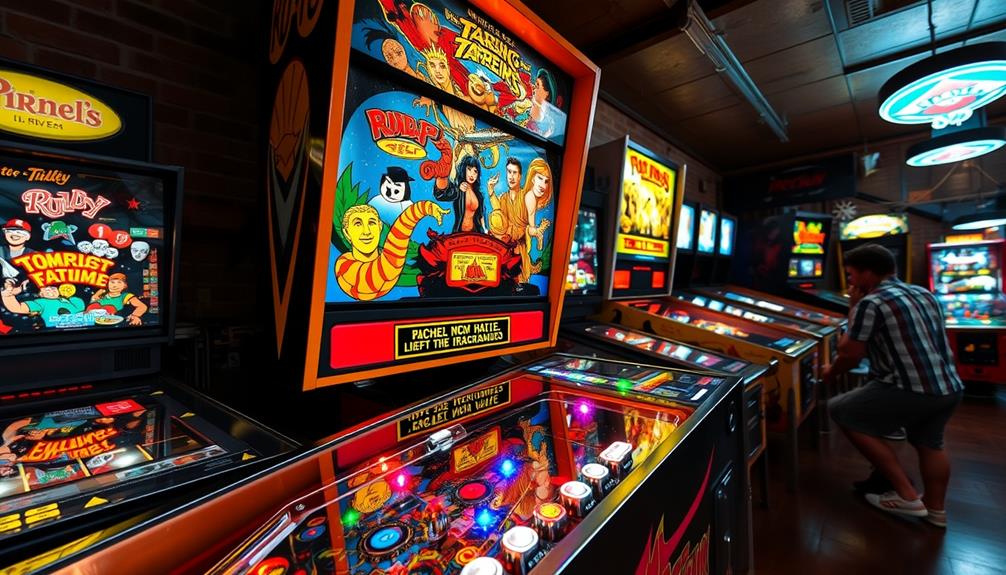Pinball machines were considered illegal primarily due to the perception that they were gambling devices that promoted crime and juvenile delinquency. During the Great Depression, these machines were associated with moral decay and organized crime, causing widespread public alarm. City officials launched campaigns against them, resulting in bans in many cities, notably starting with New York City’s Mayor LaGuardia in 1942. The lack of flippers in early pinball games meant that success relied heavily on luck, reinforcing their reputation for gambling. Although pinball eventually transformed into a game of skill, the negative stigma persisted. Exploring further may reveal how pinball eventually overcame these obstacles.
Key Takeaways
- Pinball machines were viewed as gambling devices, raising concerns about youth morality and addiction during the early 20th century.
- Organized crime associations linked pinball to illegal gambling and money laundering, prompting public outrage and legal action.
- Civic leaders and media sensationalized pinball's connection to juvenile delinquency, framing it as a societal menace.
- Major cities, including New York City, implemented outright bans on pinball machines to curb perceived threats to public morality.
- The introduction of flippers in 1947 helped shift perceptions, but earlier associations with crime and gambling persisted, affecting legalization efforts.
Historical Origins of Pinball
Pinball machines have fascinating roots that trace back to the 18th century, evolving from the French game bagatelle. This early parlor game featured a cue ball and holes on a board, setting the stage for what would become a cultural phenomenon.
By 1931, the first true pinball machine emerged, shifting to coin-operated devices. This innovation changed the landscape of gaming, but it also sparked controversy. The evolving nature of games often reflects societal attitudes, much like how astrology explores personality traits linked to attractiveness.
Early pinball machines lacked flippers, emphasizing chance over skill, which led authorities to classify them as gambling devices during the Great Depression. As players dropped coins in hopes of winning, concerns about pinball's association with illegal gambling grew.
Many cities in the U.S. started to associate pinball with juvenile delinquency, believing it encouraged reckless behavior among youth.
Early Perceptions and Associations

In the early 20th century, you'd likely see pinball machines as little more than gambling devices, with players hoping to win prizes.
This perception grew stronger as people blamed pinball for youth delinquency and connected it to organized crime, painting a picture of moral decay.
The intense emotions associated with gambling and addiction, much like those found in individuals with Borderline Personality Disorder (BPD), fueled fears surrounding the impact of pinball machines on society.
As these associations spread, cities began to crack down on pinball machines, viewing them as a threat to society.
Gambling Associations and Concerns
Many people in the early 20th century viewed pinball machines as nothing more than gambling devices. With their coin-operated nature and the potential to win small prizes, these machines raised alarms about youth and public morality.
The absence of flippers meant outcomes relied heavily on chance, solidifying their reputation as games of luck rather than skill. This association heightened fears about the impact on young players, similar to concerns over toilet paper disposal issues that can lead to clogs and plumbing problems.
As pinball gained popularity, links to organized crime emerged. Authorities highlighted connections between pinball operations and illegal gambling rackets, leading to widespread bans in cities like New York and Chicago.
Public sentiment turned sharply against pinball, fueled by media sensationalism that painted the machines as breeding grounds for juvenile delinquency and crime. Civic leaders launched campaigns to eliminate them from public spaces, fearing for the welfare of their communities.
Key concerns included:
- Pinball machines as tools for gambling
- Impact on youth behavior and morals
- Connections to organized crime
- Legal bans aimed at curbing illegal gambling
These concerns ultimately shaped the perception of pinball machines as a societal menace, leading to their eventual illegality in many areas.
Youth Delinquency Stigmatization
The perception of pinball machines as a menace to youth developed rapidly in the 1940s, fueled by widespread concerns about juvenile delinquency. Critics, including law enforcement and civic leaders, argued that pinball machines weren't just harmless entertainment but instruments of financial exploitation. They claimed these machines lured vulnerable children into a world of gambling and contributed to their moral decline.
The public outcry was palpable, as media sensationalized the connection between pinball and youth delinquency, promoting campaigns for prohibition. This early stigmatization was further reinforced by a lack of understanding regarding the importance of keyword research, which limited the discourse on pinball's cultural significance.
Pinball became synonymous with organized crime, as testimonies suggested that gangs operated machines to facilitate illegal gambling and money laundering. This association deepened the stigma surrounding pinball, painting it as a corrupting influence on children.
Even as pinball machines evolved into skill-based games with the introduction of flippers in 1947, the negative perceptions persisted. Many adults viewed pinball as a gateway to delinquency, reinforcing the idea that playing these machines could lead to a life of crime.
This early stigmatization of pinball shaped its reputation for decades, overshadowing its qualities as a legitimate game of skill.
Organized Crime Connections
Pinball's notorious association with organized crime fueled public fear and skepticism throughout the 1940s. The pinball industry became a focal point for controversy as gangsters exploited machines for money laundering and illegal gambling. This connection was reinforced by figures like Mayor Fiorello LaGuardia, who labeled pinball a gambling racket controlled by the mob. His stance amplified public opposition, ultimately leading to legal bans in 1942.
The philosophical exploration of societal norms during this time encouraged deeper self-reflection on the moral implications of such pastimes, paralleling the concerns of individual rights versus collective good as seen in utilitarian thinkers' declarations.
Media sensationalism played a significant role in shaping perceptions, often framing pinball as a corrupting influence on youth and a threat to public morals. The narrative surrounding pinball machines highlighted concerns about their impact on society, including:
- Links to mob activity and organized crime
- Associations with juvenile delinquency
- Claims of undermining public morals
- Justifications for legal bans based on societal fears
These factors combined to create a climate of distrust around pinball. Politicians often cited the machines' connections to crime and delinquency as reasons for prohibition. The collective response reflected a broader anxiety about the potential dangers of this seemingly innocent pastime, leading to its illegality in many cities.
The Role of Organized Crime

In the gritty streets of 1940s Chicago, pinball machines became more than just arcade attractions; they turned into instruments of organized crime. Mobsters exploited these machines for gambling, using them to launder money and fund illicit operations. This exploitation mirrors how ethical hacking is employed to identify vulnerabilities in systems, albeit in a vastly different context.
Testimonies from officials, including the Kings County District Attorney, linked pinball machines directly to organized crime syndicates, which only heightened public concern.
As the media sensationalized pinball's association with gambling, they painted it as a tool for exploitation, fueling a moral panic. Civic groups and law enforcement rallied against the machines, arguing they corrupted youth and allowed organized crime to profit from the vulnerable.
This atmosphere of outrage led to citywide bans, with figures like New York City's Mayor Fiorello LaGuardia leading the charge. In 1942, he initiated a crackdown on pinball machines, viewing them as a significant threat to public morality.
The combination of organized crime's influence and rising public concern created a perfect storm that ultimately led to the widespread prohibition of pinball machines across many cities.
Government Bans and Legislation

As public outrage mounted over pinball machines and their ties to organized crime, city governments responded with sweeping bans aimed at curbing their influence. In New York City, for instance, Mayor Fiorello LaGuardia led the charge against pinball, enacting a ban on January 21, 1942. This legislation resulted in the confiscation and destruction of thousands of machines, reflecting a broader sentiment shared by other major cities like Chicago, Los Angeles, and Milwaukee.
Concerns about the economic implications of such gambling-like activities drew parallels with the need for financial health, as authorities sought to protect citizens from potential financial ruin.
These bans stemmed from concerns about pinball's impact on youth and public morality. Key factors contributing to the legislation included:
- Perceived connections to gambling and organized crime
- Fears about the games' addictive nature
- The belief that pinball lacked any real skill
- A desire to protect public spaces from vice
It wasn't until the California Supreme Court ruled in 1974 that pinball was a game of skill that many local bans began to falter.
Roger Sharpe's successful demonstration in 1976 further shifted perceptions, paving the way for the eventual lifting of the New York City ban and a renewed acceptance of pinball across the country.
Public Sentiment and Media Influence

Public anxiety over pinball machines in the 1940s reached a fever pitch, largely driven by media portrayals that exaggerated their connections to gambling and organized crime. This moral panic was fueled by concerns that pinball contributed to juvenile delinquency, leading to widespread calls for bans in urban areas.
| Influence | Impact |
|---|---|
| Media Sensationalism | Amplified fears of gambling and crime |
| Public Sentiment | Shifted towards viewing pinball as corrupting |
| Anti-Pinball Campaign | Led by Mayor LaGuardia, emphasized moral necessity |
| Community Activism | Civic groups rallied support for bans |
| Legal Prohibitions | Resulted in widespread bans across cities |
The media's portrayal of pinball as a gambling racket intensified backlash, framing it as a threat to public morality. Activist campaigns by churches and law enforcement further stigmatized the game, shaping perceptions that pinball was detrimental to youth. As the anti-pinball campaign gained momentum, it became clear that public sentiment, heavily influenced by media narratives, played a significant role in the machines' legal prohibitions.
Cultural Stigmatization of Pinball

Throughout the mid-20th century, pinball machines became cultural pariahs, largely due to the perception that they posed a significant threat to youth. Critics saw pinball as a gateway to gambling, exploiting vulnerable children and fueling fears of juvenile delinquency.
The media played a key role, sensationalizing stories that linked pinball to moral panic and amplifying public concerns. This reflects how societal fears can shape perceptions of creativity and play, much like the challenges we see today with igniting creativity in a digital world.
Mayor Fiorello LaGuardia of New York City famously characterized pinball as a mob-controlled gambling racket, further entrenching its negative reputation. Despite the introduction of flippers in 1947, which made the game more skill-based, the stigma persisted.
This sustained campaign against pinball shaped public perception, reinforcing its image as a corrupting influence rather than a legitimate form of entertainment.
Key factors in this cultural stigmatization included:
- The association with gambling mechanics
- The portrayal of pinball as a threat to youth
- Civic leaders and churches condemning the game
- Links to organized crime and illicit activities
As a result, pinball machines remained illegal in many areas, locked in a battle against the cultural fears that defined their existence for decades. The history of pinball bans is a testament to the struggle of these machines to gain cultural acceptance. Even after the bans were lifted in some areas, they still faced stigma and were often associated with illegal gambling. It wasn’t until the late 1970s and early 1980s that pinball began to shed its negative reputation and regain popularity as a legitimate form of entertainment.
The Flipper and Industry Changes

Innovation in pinball took a dramatic turn with the introduction of flippers in 1947, reshaping the landscape of the industry and its societal perception. Before flippers, pinball machines were seen primarily as a game of chance, heavily tied to gambling. This association led to widespread bans in cities across the U.S. during the 1930s and 1940s.
However, flippers changed everything by giving players greater control and engagement, transforming pinball from a mere game of chance into a true game of skill. This shift in gameplay parallels advancements seen in other entertainment technologies, such as modern energy-efficient models that greatly enhance user experience.
With this shift, public perception began to change. Pinball machines started to be viewed as legitimate entertainment rather than illegal gambling devices. The flipper's innovation marked a turning point, allowing for more complex gameplay and paving the way for a renaissance in pinball machine design and production during the mid-20th century.
As players honed their skills, the demand for these machines surged, leading to a gradual acceptance and eventual legalization in the 1970s. Ultimately, flippers not only revitalized the industry but also redefined how society viewed pinball, setting the stage for its enduring popularity.
Legalization Efforts in the 1970s

As pinball gained popularity in the 1970s, efforts to legalize it intensified, spurred by pivotal court rulings and public demonstrations.
The turning point came in 1974 when the California Supreme Court declared pinball a game of skill rather than chance, a notion that resonates with the idea of astrology and attractiveness influencing perceptions of skill and charm. This ruling opened the door for further legalization efforts across the nation.
One of the most significant moments occurred in April 1976 when Roger Sharpe demonstrated his skill-based gameplay before the New York City Council. His performance effectively challenged the city's ban on pinball, leading to a vital victory. Following his testimony, New York City lifted its ban, marking a cultural shift toward accepting pinball as a legitimate form of entertainment.
The momentum continued, as other cities followed suit:
- Chicago lifted its ban in 1977.
- Communities across the U.S. began to embrace pinball.
- Competitive leagues and events emerged.
- Public sentiment increasingly recognized the skill involved in the game.
The Decline of Pinball Popularity

As you explore the decline of pinball popularity, you'll see how associations with gambling led to legal bans that tarnished its image.
When video games surged in the late 20th century, they captured the public's attention, pushing pinball further into the background.
Despite its legalization, pinball struggled to regain its former status in an evolving entertainment landscape.
Association With Gambling Concerns
The rise of pinball machines in the early 20th century quickly faced backlash due to their association with gambling concerns. Many viewed these machines as a form of gambling, especially since players could win free games or prizes. The absence of flippers in early designs meant gameplay depended heavily on chance, which only fueled the perception of pinball as a gamble.
Mayor Fiorello LaGuardia famously campaigned against pinball, linking these machines to organized crime and portraying them as tools exploiting vulnerable citizens. Various cities followed suit, enacting bans due to fears of juvenile delinquency and the crime associated with pinball.
Key factors contributing to the decline of pinball included:
- Public perception of pinball as a gambling device
- Legislative bans in cities like Chicago and Los Angeles
- Concerns over organized crime's influence
- Moral panic surrounding youth corruption
As a result, pinball's popularity waned, relegating it to underground venues. Legal challenges in the 1970s eventually shifted public perception, but the stigma of gambling concerns lingered, shaping the narrative around pinball machines for decades.
Rise of Video Games
By the late 1970s, a seismic shift in entertainment emerged as video games captivated audiences, pulling them away from traditional pinball machines. Iconic titles like "Pong" and "Space Invaders" offered interactive gameplay that drew you in, making the static experience of pinball seem outdated.
As you explored local arcades, video games began to dominate the scene, highlighting the decline of pinball's popularity.
The mid-1980s marked a turning point for the pinball industry. Revenue fell sharply, and major manufacturers struggled to keep up with the booming video game market. Consumer preference shifted dramatically as players gravitated toward the evolving gaming landscape filled with elaborate graphics and engaging storylines.
As video game arcades became more prevalent, you likely noticed fewer pinball machines in public venues. This dwindling number further solidified pinball's decline as a dominant form of entertainment.
The allure of arcade games not only reshaped your gaming experience but also marked a significant decline for pinball, leaving many to wonder if it could ever reclaim its former glory in a world captivated by digital innovation.
Legal Bans and Prohibition
With video games taking center stage in the entertainment industry, pinball machines faced not just a decline in popularity, but also legal challenges that further threatened their existence.
In the 1940s, cities across the U.S. enacted bans on pinball, largely driven by fears of gambling and organized crime. New York City Mayor Fiorello LaGuardia led the charge in 1942, asserting that these machines exploited vulnerable citizens and were mob-controlled. He oversaw the confiscation of over 2,000 machines.
Critics linked pinball to concerns about juvenile delinquency, claiming it was a corrupting influence. The legal landscape began to shift when the California Supreme Court ruled in 1974 that pinball was a game of skill, not chance. This ruling challenged the prevailing stigma and ignited efforts to overturn bans in various cities, including New York City in 1976.
Key factors that contributed to the decline of pinball popularity included:
- Association with gambling
- Organized crime connections
- Concerns over juvenile delinquency
- Public outcry and government intervention
The gradual lifting of bans in the late 1970s marked a cultural shift, allowing pinball to reclaim its place as a legitimate form of entertainment.
Resurgence of Pinball Culture

Often overlooked in the gaming landscape, pinball is experiencing a vibrant resurgence that's enchanting enthusiasts and newcomers alike. With over 1,800 tournaments organized annually by the International Flipper Pinball Association, you'll find a lively community where players of all skill levels can bond over their shared passion.
Modern machines, equipped with advanced technology and popular themes, attract a diverse audience, making the pinball experience more engaging than ever.
The rise of retro gaming and nostalgia has birthed new venues and pinball museums, celebrating the rich history of this beloved pastime. Community leagues, like the Western Mass Pinball League, foster camaraderie and a competitive spirit, contributing greatly to the culture's revival.
You're likely to witness an inclusive environment as increased participation from women leads to the formation of women-led leagues and tournaments, breaking traditional barriers.
This resurgence isn't just about playing games; it's about connecting with others who share a love for pinball. As you engage with this culture, you'll discover a welcoming community that celebrates both the past and the exciting future of pinball.
Immerse yourself, and you might just find your new favorite game!
Frequently Asked Questions
Where Is Pinball Still Illegal?
Pinball's still illegal in places like Ocean City, New Jersey, on Sundays, and in Grove City, Ohio. Even Nashville had restrictions until 2004, demonstrating how local laws can affect your access to pinball machines.
Why Was There a 35 Year Ban on Pinball?
You might wonder why pinball faced such a long ban. The association with gambling, organized crime, and public concerns about morality led cities to see it as a threat to youth, resulting in decades of prohibition.
Why Were Pinball Machines Illegal in New York?
Imagine a bustling arcade, where vibrant lights flicker like fireflies. Yet, in New York, pinball machines became shadows of vice, linked to crime and mischief, leading to their ban amid a moral crusade against perceived corruption.
Why Was Pinball Outlawed in California?
Pinball was outlawed in California due to its association with gambling and concerns about its impact on youth. Authorities viewed it as a game of chance, leading to widespread confiscation and legal restrictions.
Conclusion
In the end, pinball machines went from being banned to beloved staples of entertainment. Take the case of New York City in the 1970s, where a group of passionate players rallied against the ban, ultimately leading to a landmark decision legalizing pinball. This shift not only rejuvenated the arcade scene but also highlighted how a simple game can unite communities. So next time you play, remember the journey pinball took to become the cherished pastime it is today!









